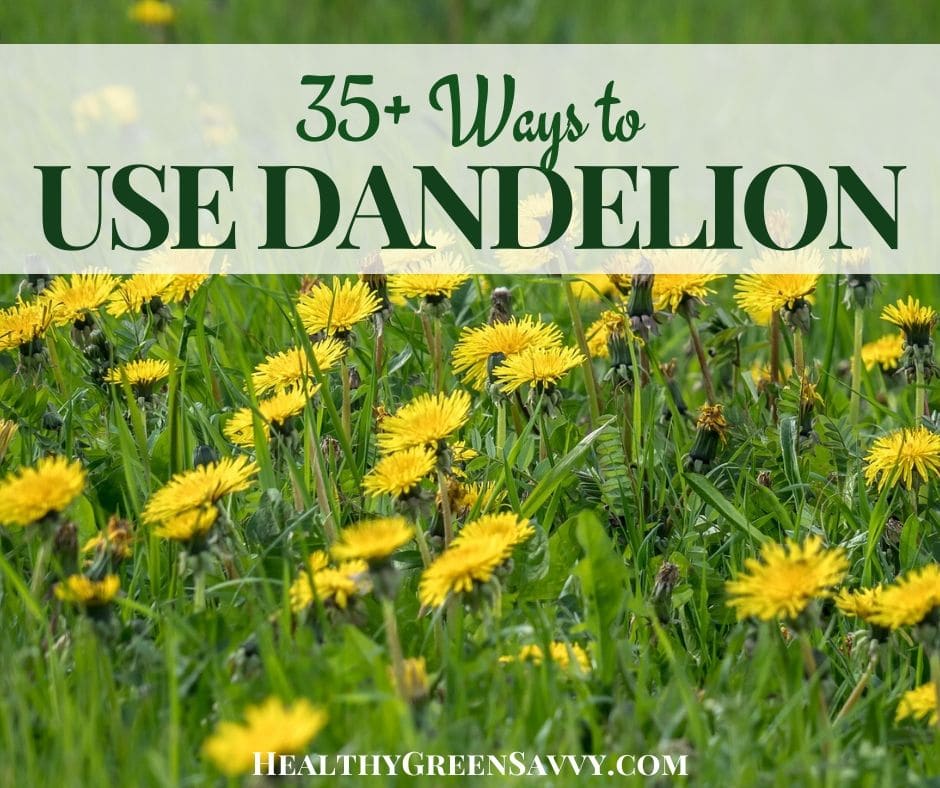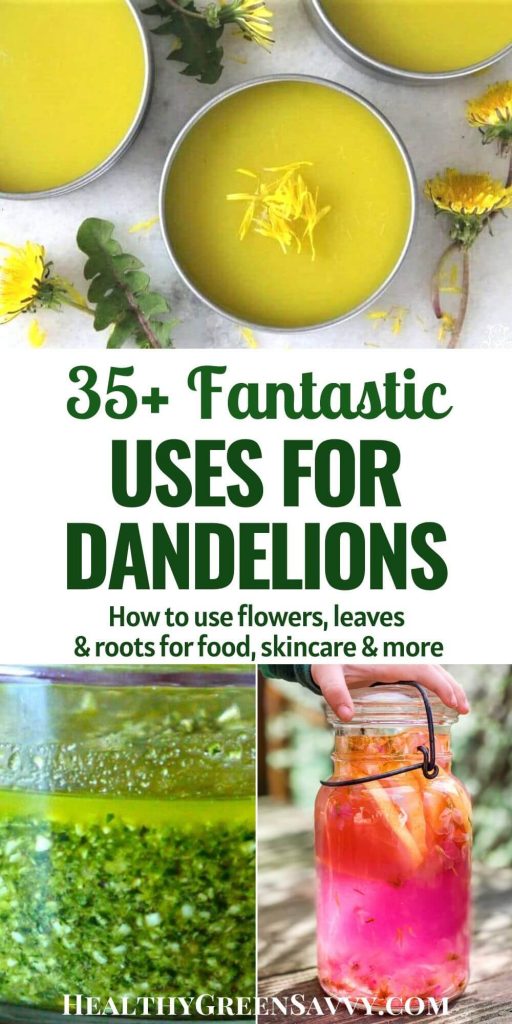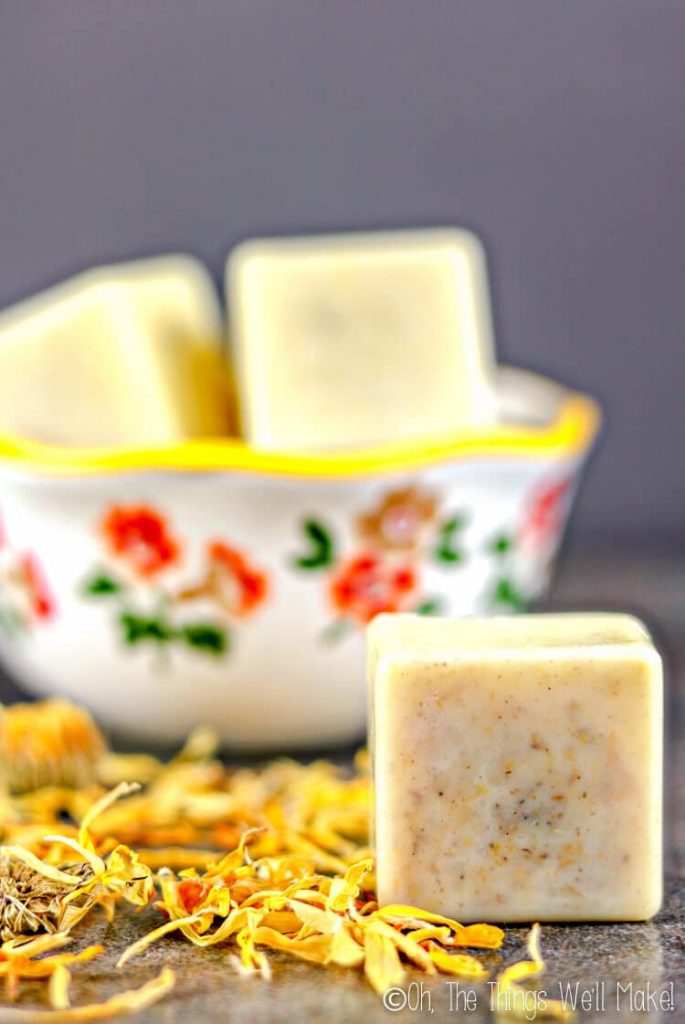Last Updated on October 23, 2024
While most of us were taught to loathe this tenacious garden invader, it turns out dandelions have much to recommend them. One of most home foragers’ favorite edible weeds, dandelions are nutritional and medicinal powerhouses worth getting to know. Before you start pulling or poisoning these impressive plants, consider eating your dandelions! Here’s how to eat dandelions and more than 35 ways to enjoy the health benefits of dandelion.
Can You Eat Dandelions?
Lawn devotees everywhere pretty much universally despise dandelions. But as more of us come to realize both what an environmental nightmare grass lawns are and how many so-called weeds have significant nutritional and medicinal value, dandelions are garnering more and more appreciation. Like they used to — when Europeans intentionally brought them to North America as a food source.
I consider dandelion among the many wonderful perennial vegetables and perennial herbs that are easy to incorporate into your home landscape.
Here’s more on dandelion’s long history of use for food and medicine. And there are likely many more edible flowers growing near you — here’s a list of more than 150 flowers you can eat.
Whether or not you’re into herbal medicine or foraging, you might want to reconsider your relationship to dandelions for three reasons:
- Dandelions are both nutritious and delicious, making harvesting dandelions a useful way to get more food from your yard.
- Dandelions have a number of useful medicinal properties, making them a readily-available source of herbs to support better health.
- They’re an important early food for pollinators, who need all the help they can get.
Maybe you’re reading this because like me, you’re fascinated by the possibility of using the power of plants to support health. And getting super healthy food for free right outside your door is just plain cool.
All parts of the dandelion are edible, including the flowers, leaves, and roots, as well as the stems and seeds, though those are used less often. The greens and roots are considered especially useful for supporting the liver’s function as a detoxifier.
Read on to learn more about the impressive health benefits of dandelion and perhaps you’ll also start viewing them as a bonus crop in your garden rather than the bane of your summer existence. (Leave that for mosquitoes. Here’s an effective natural mosquito control method for dealing with those.)
Other common “weeds” you might not have realized are edible include Virginia waterleaf, edible chickweed, wood sorrel, edible clover, and creeping Charlie. Cleavers is another common wild plant with edible and medicinal uses. It’s among the dozens more wild herbs you can forage.
Health Benefits of Dandelion
- The greens are extremely nutritious, full of vitamins and minerals, like vitamins A & K, and calcium as well as magnesium and potassium. (Nutrition data here.) They’re also rich in antioxidants and polyphenols, which have been shown to protect health in numerous ways.
- Dandelions contain a number of beneficial plant compounds and are being studied for diverse uses in disease treatment, including cancer and type 2 diabetes.
- Dandelion is a diuretic, one of the reasons it’s considered helpful for flushing out waste. Herbalists turn to dandelion for liver support, which helps to remove metabolic waste from the body.
- The root contains inulin, a prebiotic (good for gut health), as well as bitter compounds considered valuable for digestion.
- Compounds in dandelion flowers are considered very soothing to the skin, so you’ll find them starring in a number of soaps, salves, and lotions in much the same way as calendula. You’ll find some ideas below.
According to herbalist Maud Grieve, “The name of the genus, Taraxacum, is derived from the Greek taraxos (disorder), and akos (remedy), on account of the curative action of the plant.” Dandelion long held a place in both the British and American pharmacoepias.
Here’s a pretty extensive rundown of dandelion’s medicinal uses over the centuries, all over the world.
In The Green Pharmacy, James Duke highlights the lecithin in the flowers, which he says “has been proven useful in various liver ailments” and potentially supports brain health. He recommends the greens and roots for upper respiratory infections and notes that herbalists often use the milky sap to treat warts.
If you’re as fascinated by plant medicine as I am, you should check out the stunning array of herbal courses offered by The Herbal Academy. Here’s a list of the courses they’re currently enrolling.
Dandelions are in the asteraceae family, along with calendula, chamomile, buzz button, and ragweed. If you have a ragweed allergy, you may want to be careful about consuming dandelion, the flower especially, though allergies to dandelion aren’t common. Here’s more on cautions and drug interactions from WebMD. Note that dandelion may interact with antibiotics, lithium, and other medications, and may also slow blood clotting. As with any herb, you should discuss any contraindications with your doctor before consuming.
If you’re curious about the many other medicinal plants you can cultivate, check out this post on starting a medicinal herb garden and this list of the best herbalism books.
Identifying Dandelions
So now that you’re sold on the health benefits of dandelion, what do you need to know about foraging them?
First, no matter what you’re foraging, positive plant identification is always critical. Every forager needs a good field guide to consult before foraging any plant for the first time. Here are some of my favorite foraging books to stock your foraging reference shelf.
You probably already know what a dandelion looks like, but it’s always wise to confirm that you’re harvesting the right plant. One of my favorite foraging experts, “Wild Man” Steve Brill reports of dandelion:
There are no poisonous look-alikes. Other very similar Taraxacum species, as well as chicory and wild lettuce only resemble dandelions in the early spring. All these edibles also exude a white milky sap when injured, but chicory and wild lettuce leaves have some hair, at least on the underside of the midrib, while Taraxacum leaves are bald.
Note that dandelion leaves are smooth rather than hairy and always have only one flower per stem. If you’ve got something that looks like a dandelion but has hairy leaves or multiple flowers per stem, you’ve likely found something called cat’s ear, which is apparently also edible.
Other plants that bear some resemblance to dandelion include wild lettuce (Lactuca), sow thistle (Sonchus), and hawkweed (Hieracium).
If you’re newer to foraging check out some of the other best wild edible plants for beginners.
Tips for Foraging & Using Dandelions
This may sound obvious, but please be sure to harvest your dandelions from areas that haven’t been treated with herbicides. Your own yard probably has some dandelions — and you’re not poisoning your yard, right? (That ain’t healthy, green, or savvy. Here’s more on why you might want to ditch the lawn and consider grass alternatives instead.)
If you’re foraging on public lands, you should assume they may have been sprayed unless you definitively know otherwise. I’ve found that even organizations that promote environmental responsibility still sadly choose to spray dandelions with dangerous chemicals in the pursuit of a grass lawn unmarred by weeds. Sigh.
If you do find an area with untreated dandelions, make sure you have permission to forage there. While it’s hard to imagine anyone objecting to your removing what are widely considered weeds, not everyone is keen to have foragers on their land.
Smaller, younger leaves will always be more tender and less bitter; choose leaves at the center of the plant and harvest before the plant flowers if possible. The leaves become more bitter as the season progresses, so harvest leaves early in the season if you plan to enjoy them raw and want less bitterness, ideally before flowers appear.
Brill reports that fall frosts will also help remove some of the bitter flavor. Older, more bitter greens may be more palatable cooked than raw. All greens are best picked in the morning, while they still retain the moisture they gain overnight. They’ll be less plump and juicy picked later in the day.
Harvest flowers when they’ve just opened. Both greens and flowers are best used immediately, but they can be put in airtight containers in the refrigerator for a couple of days if you can’t get to them right away.
Roots are typically harvested in fall and early winter, when they’re considered most medicinally potent, but some people report better flavor in the spring.
Nowhere to forage or prefer not to? No problem! You can find numerous options for teas, tinctures, and more online.
Ready for some fantastic ways to enjoy the benefits of dandelion? Here are more than 35 recipes for the greens, flowers, and roots, plus how to use this plentiful garden herb in skincare!
How to Eat Dandelions: Dandelions Greens Recipes
If you like bitter greens, you’ll love dandelion leaves, which have a little bite like arugula. I use them primarily in salads and as pizza toppings. If you’ve ever enjoyed a pizza topped with arugula, you’ll likely also go for dandelion greens.
Dandelions are just one of the many wild greens to explore this season.
♦ I’m a huge fan of addictive baked kale chips, so I’m very curious to try this dandelion chip recipe from Edible Wild Food.
♦ Dandelion tea is a fun wild tea you can make from leaves, flowers, or roots. Try them all! Here’s how to make dandelion tea.
♦ Dandelion greens are one of many green things besides basil you can turn into pesto. Try this dandelion pesto recipe from Learning and Yearning.
♦ Dandelion greens work well in salads, adding that lovely note of bitterness. Here’s a delicious dandelion salad from Umami Girl.
♦ Sauteed and braised dandelion greens have been a popular side dish for centuries. Here’s a recipe for sauteed dandelion greens from Confessions of an Overworked Mom.
♦ Dandelion greens can be used in all sorts of soups. Here’s a dandelion and lentil soup from Saveur and a cream of dandelion soup from Nature’s Nurture that uses the flowers and buds as well as the greens. If a lighter soup is what you’re after, try this dandelion soup recipe from Wild Food Girl.
♦ A Beautiful Plate fries up some sautéed dandelion greens with eggs for a stunning breakfast or dinner.
♦ Dandelion greens also work well in frittatas, like this dandelion greens frittata from Stacy Snacks Online.
♦ Sautéed dandelion greens work like escarole in pasta dishes as well. Here’s a recipe from Eat Smarter.
♦ Dandelion greens are also a great addition to smoothies. Here’s a delicious dandelion detox green smoothie from Tasting Page. Or try this green smoothie with dandelion and nettle from Simply Beyond Herbs.
♦ Even the stems of dandelion can be eaten! Here’s a recipe for lacto-fermented dandelion stems from Rosalee de la Forêt.
–> Looking for more tasty foraged greens to enjoy? You need to try purslane, one of the most nutritious “weeds” out there. Learn how to identify purslane and check out more than 20 healthy purslane recipes from around the world to inspire you!
How to Eat Dandelions: Dandelion Flowers Recipes
Dandelion flowers are used as additions to sweets like muffins and jelly and have a honeylike flavor. Only the yellow part of the dandelion flower is tasty; the green sepal around the flower petals is bitter and you’ll likely want to skip that.
–> Make sure to leave plenty of flowers for bees and other pollinators, especially at the beginning of the season, when there’s not a lot for them to eat.`
♦ Try your hand at homemade dandelion wine, like this one from Common Sense Home.
♦ Grow Forage Cook Ferment has recipes for making dandelion mead or dandelion kombucha.
♦ This dandelion soda recipe from Homestead Honey uses a fermented ginger bug for carbonation.
♦ Primally Inspired combines the goodness of wild violets with that of dandelion flowers in this violet dandelion lemonade.
♦ This easy dandelion tea from Wellness Mama looks like a wonderfully refreshing drink on a hot summer’s day.
♦ I discovered how fun it was to bake with flowers when I was testing elderflower recipes last summer. This dandelion muffin from Fresh Bites Daily is on the healthy side if you use a whole grain flour. Or try this dandelion lemon paleo cupcake from Forest and Fauna. If you have flowering rhubarb, you could throw some of those flowers in as well.
♦ An intriguing dandelion banana bread recipe from Edible Wild Food uses buckwheat flour.
♦ Healthy Green Kitchen uses dandelion flowers in pancakes. What a fun summer breakfast idea! Here’s a vegan dandelion flower pancake recipe from One Green Planet as well.
♦ These amazing-looking dandelion beet bars from Moon and Spoon and Yum use whole dandelions!
♦ This lower sugar dandelion jelly recipe from Commonsense Home looks like a delectable way to enjoy dandelion blossoms.
♦ In addition to numerous treats, you can use dandelion blossoms in savory recipes as well. Nature’s Nurture shares a recipe for dandelion blossom burger from and Red and Honey uses dandelion blossoms in dandelion fritters.
♦ This dandelion frittata recipe from Mountain Rose Herbs uses dandelion flowers and nettle for a fantastically healthy dinner or breakfast.
♦ You can add the goodness of dandelion to any dish if you have dandelion infused vinegar on hand. Grow Forage Cook Ferment will show you how easy it is to preserve dandelions in vinegar.
♦ The always inventive Ashley at Practical Self Reliance turns her dandelion buds into capers.
How to Eat Dandelions: Using Dandelion Root
The roots can be cooked and eaten as a vegetable or roasted to make a healthy coffee substitute. If you want to try dandelion “coffee,” here’s how to harvest and use the roots to make a rich tea that’s considered especially useful for liver support. If you’re not quite up to harvesting the root yourself, you can buy dried dandelion root by the pound online.
♦ Here’s how to cook dandelion root from Practical Self Reliance.
♦ This dandelion chai recipe from Learning and Yearning looks divine.
♦ Dandelion root can be mixed with other health-supporting herbs like nettle and hibiscus. This overnight decoction of dandelion root and nettles from Eat Beautiful also uses dandelion leaf.
♦ Practical Self Reliance preserves the medicinal properties of dandelion root in dandelion tincture.
How to Use Dandelion for Skin Care
Dandelion is also a valuable ingredient in skin care, where it’s prized for its anti-inflammatory and soothing properties.
♦ Mommypotamus makes a soothing dandelion salve, pictured below.
♦ The Nerdy Farm Wife uses the pain-relieving and skin-soothing properties of dandelion in this dandelion magnesium lotion and dandelion lotion bar
♦ Scratch Mommy uses dandelion flowers in a dandelion lip balm and this dandelion-infused hand lotion.
♦ Oh, The Things We’ll Make uses dandelion flowers in dandelion lotion bars (below).
Do you eat dandelions from your yard? What are your favorite ways to eat dandelions?
Looking for ways to use other common wild foods? Check out our wild food recipes collections:
- 16 Garlic Mustard Recipes
- 25 Wild Violet Recipes
- 25 Inspiring Spruce Tip Recipes
- 25 Serviceberry Recipes to Try This Season
- 30 Lambs Quarter Recipes
- 15 Mulberry Recipes
- 15 Best Aronia Berry Recipes
Pin this info on how to eat dandelions for later!
Can you eat dandelions photo credits: Thomas B, Learning and Yearning, Primally Inspired, Moon and Spoon and Yum, Mommypotamus, Oh, The Things We’ll Make
Disclaimer: I’m a health & green living enthusiast, not a medical professional. Content on this website is intended for informational purposes only and is not meant to provide personalized medical advice. I draw on numerous sources, some of which are linked above. Please consult them for more information and a licensed professional for personalized recommendations.

Susannah is a proud garden geek and energy nerd who loves healthy food and natural remedies. Her work has appeared in Mother Earth Living, Ensia, Northern Gardener, Sierra, and on numerous websites. Her first book, Everything Elderberry, released in September 2020 and has been a #1 new release in holistic medicine, naturopathy, herb gardening, and other categories. Find out more and grab your copy here.









 Hi, I'm Susannah, a garden geek, energy nerd, and fan of healthy food and natural remedies. Need some simple, practical solutions for living healthier and greener? You've come to the right place! More about me and my green projects
Hi, I'm Susannah, a garden geek, energy nerd, and fan of healthy food and natural remedies. Need some simple, practical solutions for living healthier and greener? You've come to the right place! More about me and my green projects